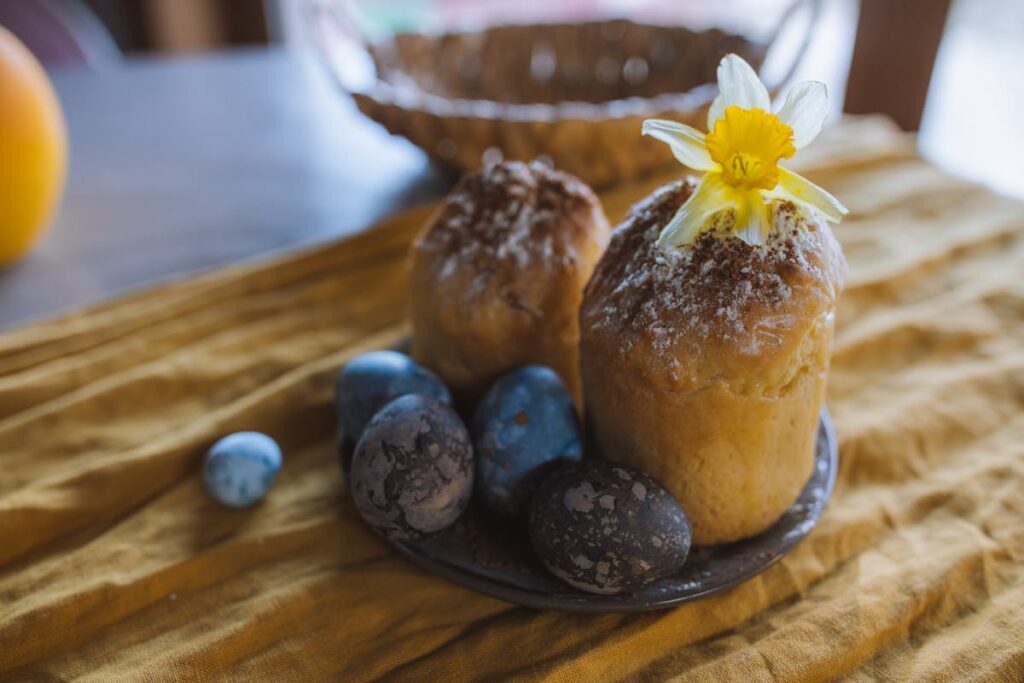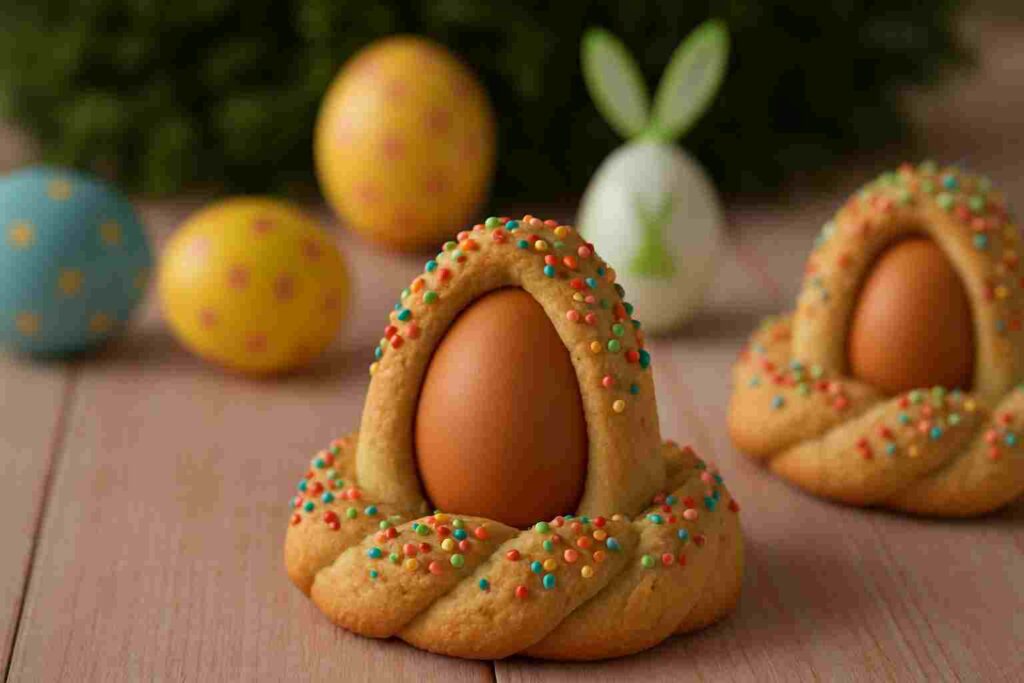Easter Bread
Easter Bread is more than a simple mix of flour, water, and yeast — it’s a beloved family recipe with deep roots in Italian tradition. Across Italy, each region has its treasured version of Easter Bread, carefully handed down through generations. Some include fresh eggs, others rich olive oil, creamy milk, aromatic spices, or distinctive local cheeses.
Let’s start a culinary exploration across Italy to uncover this centuries-old tradition of Easter Bread. Our “tour” reveals surprising flavor connections between regions separated by considerable distances. Despite geographic divides, these shared Easter bread customs remind us how traditional foods create invisible bonds – keeping us connected even when physically apart.
These recipes are significant because they’ve evolved uniquely in each community while maintaining their essential character. The careful balance of ingredients tells stories of local history, available resources, and family preferences shaped over countless springtime celebrations.

A journey through Italy’s Easter Breads
Alpine Easter Flatbread
The Valle d’Aosta region offers a savory Easter tradition—a rich leavened flatbread made with flour, eggs, olive oil, butter, and milk. What gives it distinctive character is the generous addition of Parmesan and Pecorino cheeses, plus freshly ground pepper. Family tables traditionally feature this bread sliced alongside various salamis during Easter lunch gatherings.
Venetia “Fugassa” sweet bread
Legend traces this sweet flatbread to a resourceful Treviso baker who transformed ordinary bread dough into something special for Easter celebrations. Despite modest means, he enhanced his dough with precious ingredients – eggs, butter, and small amounts of sugar – creating something delightfully soft with a subtle sweetness. Originally a humble treat for those with limited means, modern bakers have since enriched the recipe. Today’s version requires four separate risings and comes in countless variations, sometimes featuring Marsala wine or citrus notes, shaped like traditional doves or cylindrical panettone.
Trieste’s essential Easter Bread
No Easter breakfast in Trieste would be complete without their signature “pinza” – a brioche-like creation that enhances bread ingredients with eggs and butter. Its moderate sweetness makes it versatile, pairing beautifully with savory meats, cheeses, or sweet jams. Traditional preparation began during Holy Week, requiring three separate risings and considerable physical effort to knead properly. The origins of the bread are disputed, with claims coming from both Trieste and the neighboring city of Gorizia. Its distinctive appearance – resembling a flattened, dark panettone with a glossy surface marked by three deep cuts – symbolizes Christ’s sacrifice.
Ligurian Easter Baskets
These delightful Easter treats from Liguria are small bread baskets, each intricately crafted to hold a hard-boiled egg. Unlike traditional bread, they have a pleasant shortbread-like texture, thanks to the enriched dough made with butter, eggs, sugar, and the aromatic flavors of anise and fresh lemon zest. These delightful Easter treats from Liguria are small bread baskets, each intricately crafted to hold a hard-boiled egg. Unlike traditional bread, they have a pleasant shortbread-like texture, thanks to the enriched dough made with butter, eggs, sugar, and the aromatic flavors of anise and fresh lemon zest.

Tuscan country bread
Families in Tuscany’s Val d’Orcia and Valdichiana regions prepare “ciaccia” to celebrate Easter. This round, golden-brown loaf delivers a remarkable fragrance and subtle spiciness that immediately draws everyone to the table. Local bakers combine rustic whole-wheat flour with eggs, traditional sourdough starter, olive oil, and milk, then enhance the flavor with salt, freshly ground pepper, and generous amounts of robust cheeses like aged pecorino and parmesan. Dating back to the late 19th century, this peasant creation was traditionally left to ferment overnight beside a warm brazier, developing its distinctive character and aroma.
Romagna’s sweet Easter Loaf
Far more than a simple bread, Romagna’s “pagnotta Pasquale” shares more similarities with holiday classics like panettone or Colomba. This enriched dough incorporates plump raisins with delicate notes of vanilla and bright lemon. Easter morning traditions feature this sweet bread alongside hard-boiled eggs and thinly sliced cured meats, creating a perfect balance of sweet and savory flavors to start the celebration.
Umbria Cheese Bread
Umbria’s contribution to Easter morning showcases the region’s love affair with cheese. This savory bread incorporates a magnificent blend of parmesan, pecorino, and gruyere, sometimes heightened with black pepper. Its versatility shines when paired with local charcuterie or, following centuries-old tradition, alongside eggs benedict during Easter breakfast gatherings.
Roman rising Easter Bread
Throughout Rome and the broader Lazio region, “pizza cresciuta” appears exclusively during Easter celebrations. This moderately sweet bread forms the centerpiece of the region’s hearty Easter breakfast, where families gather to enjoy it alongside “corallina” (Rome’s distinctive salami), freshly boiled eggs, and steaming cups of rich hot chocolate, creating a memorable feast that bridges sweet and savory traditions. This unique bread offers a delightful contrast between its tender interior and more substantial crust. When baked traditionally in wood-fired ovens, it develops a characteristic dark exterior. While sharing Easter bread foundations of flour, yeast, eggs, butter, milk, oil, and sugar, what truly sets this bread apart are its aromatic elements – fresh orange and lemon zest (sometimes even tangerine), a choice of liqueurs (anise, sambuca, alchermes or maraschino), warming cinnamon and nutmeg, plus a generous spoonful of anise seeds for that distinctive Mediterranean flavor.
Abruzzo’s fragrant creation
This leavened specialty shares flavor similarities with South Tyrolean Easter bread, distinguished by additions of candied fruit, plump raisins, or chocolate chips alongside the signature anise. Regional variations seem endless, with many families incorporating cloves, cinnamon, fresh lemon zest, and favorite liqueurs to their base recipe of flour, water, yeast, sugar, eggs, and oil. The need for considerable patience remains constant across households – the bread demands two complete rising cycles to develop its perfect texture.
Sicily’s figurative bread
The beloved pupi cu l’ova represents an evolution of ancient Sicilian tradition. They descend from the historic cuddura – circular breads with embedded eggs that provided substantial nourishment for workers who could conveniently carry them under an arm during long journeys. Today’s Easter culture includes elaborate bread baskets prepared during Holy Week. Beyond flour and yeast, the recipe incorporates lard for richness, milk, eggs, sugar, and aromatic lemon zest, creating sustenance and celebration.
Basic recipe of Easter Bread
While it might look somewhat like Naples’ famous casatiello with its ring shape, the dough draws inspiration from Umbria’s celebrated cheese bread tradition. The finished braid cradles colorful eggs, those perfect symbols of new beginnings that have marked spring feasts since ancient times.
For the dough, you’ll need:
- 500g all-purpose flour
- 15g fresh yeast (about 1½ tablespoons)
- 200ml milk, slightly warmed
- 100g sugar
- 80g whole eggs (usually 1-2 depending on size)
- 10g salt
- 50g grated pecorino cheese
- 50g butter, softened
- Extra egg yolk for brushing
For decoration:
- 4 hard-boiled eggs (we dye ours with natural colorings)
The process requires patience – first, dissolve the yeast in warm milk, then combine it with other ingredients to form a smooth, elastic dough. After the initial hour-long rise at room temperature, we shape it into our family’s traditional braid pattern, tucking the colored eggs into the curves.
The shaped braid needs to double in size during its second rise before baking at 180°C (350°F) for about 50 minutes until deeply golden. The waiting is always worth it – the moment we bring this meaningful bread to the table connects us to traditions that stretch back through countless generations.
